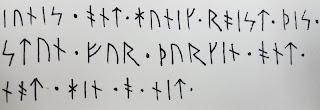I took inspiration for the stone from Runestone U153 from Lissby in Uppland, Sweden. What I created is a pretty close reproduction, but tweaked to fit this particular project.
I wanted to use the cross aspect from the stone, but changed to be a Northern Army star, as Durcain is a Northern Army fighter. I started by sketching a few of the period crosses from stones, then used attributed from them to create a star that evoked that look. The end result being... well, I kind of re-invented the star used by Duchy Von Drachen Klaue on heir shields. Which... works, because Durcain is a member of VDK.
Initial sketch for the stone. Inspired by stone U153 from Lissby. Basic, simple PR3 style.
The stone differs from period practice in a couple of ways. First, in the use of the Northern Army Star/VDK Tagma instead of the cross found on the original. Second is the inscription....
Inscription is English, transliterated into Elder Fuþarc. Stones of this period would have been in old norse, in Younger Fuþarc, but I used this method to make it easier for modern people to read, and because it's FAR easier to transliterate English (specifically modern English) into Elder. Younger has fewer letters, and I would have had to improvise replacement letters far more often.
Inscriptions on stones were pretty simple and to the point... they were being carved in stone, after all, by hammer and chisel. I opted to go with a short inscription, as close to period practice as I could.
Inscription reads: "Ioanness and Honig raised this stone for Durcain and made him a knight"

Initial roughing out of the design. I start with the outline, then move in and carve the runic text.

"Honig", finished carving.
After the carving is all done, then it's time to give the stone a bath. I scrub the stone with water and a brush, removing all the bits I have carved away, making sure to get deep into every line. On some stones, I have actually pressure washed them. Removing all the loose parts is important in making sure the paint sticks.
Then... on to painting.
Runestones definitely were painted in period. Dominant colors were reds, whites, and blacks, but other colors were possible and known. I chose to use Greens, yellows, whites, and blacks, as Durcain's colors are primarily those.


Finished!
I am damn happy with how this came out. I was extremely honored to be asked to do the stone for Durcain. I hope he's happy with it in his home.








